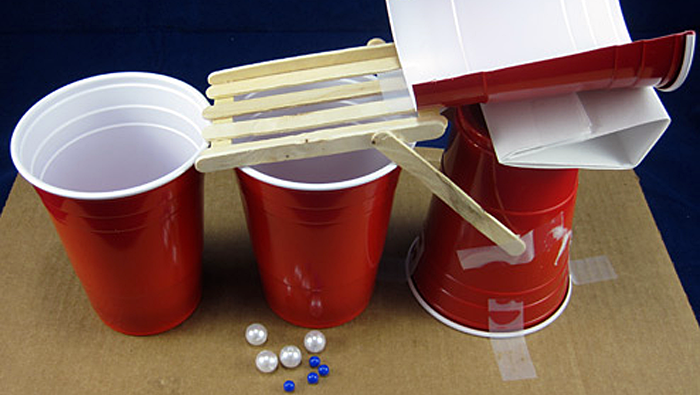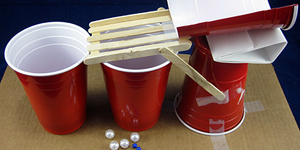Make Your Own Sorting Machine
Creative DIY STEM projects like making a sorting machine help students understand steps of the engineering design process. Plus, hands-on science activities like this are lots of fun in the classroom and give kids a practical challenge to solve.

Have you ever used a machine that you put a handful of coins into, and the coins fall into collectors based on the type of coin? This kind of machine is fun to use and makes it easy to sort your money. The machine doesn't really know the difference in types of money. What the machine is designed to do is sort objects based on size.
Sorting machines are used to automate tasks that are time-consuming to do by hand (or might even be impossible). Examples of sorting machines can be found in a wide range of jobs and real-world processes. Different sorting machines tackle different kinds of sorting tasks, but what they share is a focus on sorting based on a "property" of the materials they sort. In the case of a coin sorting machine, the machine sorts based on size. If the machine is well-designed, a quarter can't fall into the slot for dimes; similarly, if the machine is designed properly, a dime won't end up in the quarters area. (What might be wrong with the design if this happened?)
Building a simple sorting machine from ordinary craft materials is a great way for kids to explore engineering principles and to experiment with iterative design. Engineers often prototype a solution and find, once they test it, that they need to go back and make changes and then test again. Sometimes these steps are repeated multiple times in the process of creating something that works the way the engineer wants it to work and solves the specific challenge or need. Students can explore these steps of the engineering design process by making their own marble sorting machines out of plastic cups and wooden sticks.
A Fun Engineering Challenge
In the Gravity-Powered Sorting Machine family- and classroom-friendly engineering activity, students are guided in designing their own gravity-powered sorting machine to sort plastic beads (or marbles) of different sizes into separate cups. The machine will use size as the limiting property, but what other variables will be important?
If you go back to the coin sorter example, there is a risk that smaller coins will slide right on past their collection points. With the marble sorting machine, the same problem may arise. You don't want small marbles to end up in the cup for big marbles. What factors (or variables) might cause the beads to slide past their drop spot and into the wrong cup? How can you alter the design of the machine to help prevent this problem? What does gravity have to do with the design of the machine in this activity?
Can you design a working marble sorting machine? How many different sizes can your machine handle?
Put it to the test and build your own sorting machine!
Making Connections
Students interested in this STEM activity may also enjoy these engineering projects and activities at Science Buddies:
- Marble Machine
- Follow the Flow
- Balloon-Powered Car Challenge
- Flippy the Robot Dances (and Falls Apart)
- Build a Robot Hand
- Art Bot: Build a Wobbly Robot That Creates Art
- Junkbots: Robots from Recycled Materials
Engineers Week and the Science Buddies Engineering Challenge
Engineers Week (E-Week) is February 19-25, 2023.
The Science Buddies Engineering Challenge is usually announced in advance of Engineers Week and opens in the same timeframe. Directions for past challenges are available and can be used to explore engineering design with students at any time of the year.
STEM in the Classroom
Engineering activities like the Gravity-Powered Sorting Machine can be very effective as in-class projects for small groups. For other engineering projects, see the following collections of engineering challenges:
- 12+ Engineering Challenges for Elementary School
- 16+ Engineering Challenges for Middle School
- 11+ Engineering Challenges for High School
Note: a version of the Gravity-Powered Sorting Machine activity was the 2016 Science Buddies Engineering Challenge. To find out more about the annual challenge, see Science Buddies Engineering Challenge
Categories:
You Might Also Enjoy These Related Posts:
- Star Wars Projects for May the 4th Be With You Science
- Spring Science Projects: 26 Science Experiments for Spring
- 5 STEM Activities with Marshmallow Peeps
- 6 Picks for St. Patrick's Day STEM
- 12 STEM Activities for Lunar New Year - Year of the Dragon Science
- Winter Science Projects, Lessons, and STEM Activities
- Make Some New Year's Noise with Science Projects!
- Holiday STEM Projects to Make and Give










